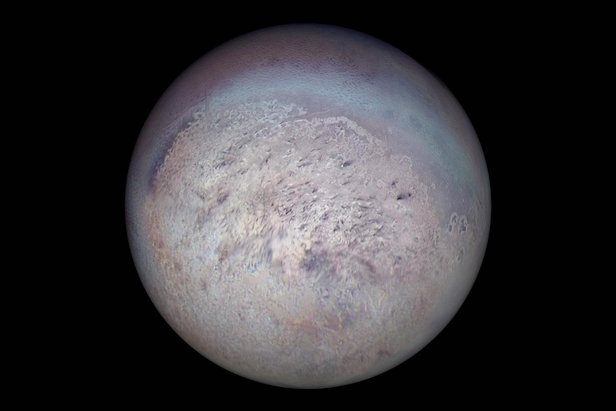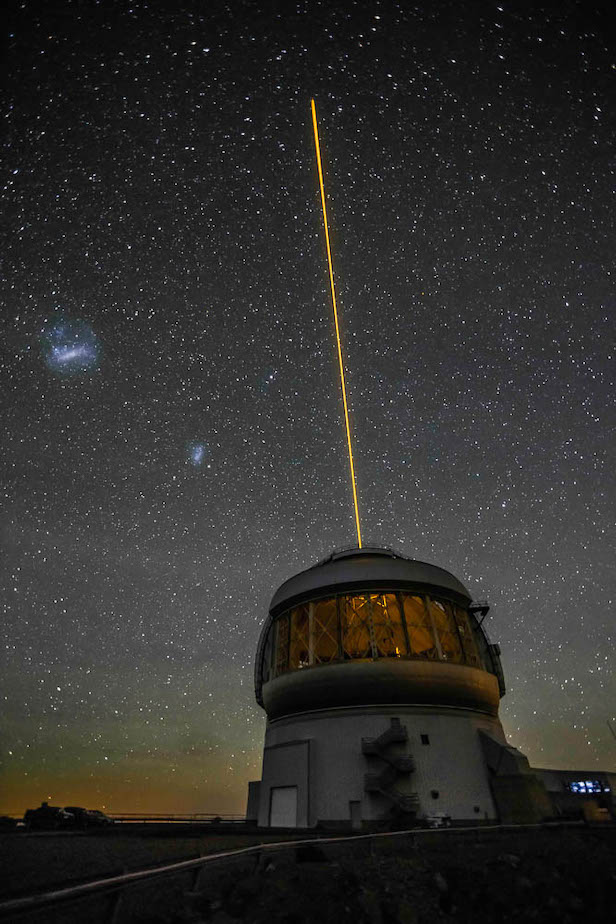Two rare ices coexist on Neptune’s moon Triton
Astronomers applied their laboratory findings to space to discover that Triton undergoes a special chemical reaction

Voyager 2 image of Triton showing the south polar region with dark streaks produced by geysers visible on the icy surface. Image credit: NASA/JPL
Astronomers using the Gemini Observatory explore Neptune’s largest moon Triton and observe, for the first time beyond the lab, an extraordinary union between carbon monoxide and nitrogen ices. The discovery offers insights into how this volatile mixture can transport material across the moon’s surface via geysers, trigger seasonal atmospheric changes, and provide a context for conditions on other distant, icy worlds.
Extreme conditions can produce extreme results. In this case, it’s the uncommon pairing of two common molecules – carbon monoxide (CO) and nitrogen (N2) – frozen as solid ices on Neptune’s frigid moon Triton.
In the laboratory, an international team of scientists have pinpointed a very specific wavelength of infrared light absorbed when carbon monoxide and nitrogen molecules join together and vibrate in unison. Individually, carbon monoxide and nitrogen ices each absorb their own distinct wavelengths of infrared light, but the tandem vibration of an ice mixture absorbs at an additional, distinct wavelength identified in this study.
Using the eight-metre Gemini South Telescope in Chile, the team have recorded this same unique infrared signature on Triton. Key to the discovery was the high-resolution spectrograph called IGRINS (Immersion Grating Infrared Spectrometer) which was built as a collaboration between the University of Texas at Austin and the Korea Astronomy and Space Science Institute (KASI). Both the Gemini Observatory and IGRINS receive funding from the United States National Science Foundation (NSF).
“While the icy spectral fingerprint we uncovered was entirely reasonable, especially as this combination of ices can be created in the lab, pinpointing this specific wavelength of infrared light on another world is unprecedented,” says Stephen C. Tegler of Northern Arizona University’s Astrophysical Materials Laboratory who led the international study. The research results have been accepted for publication in the Astronomical Journal.
In the Earth’s atmosphere carbon monoxide and nitrogen molecules exist as gases, not ices. In fact, molecular nitrogen is the dominant gas in the air we breath, and carbon monoxide is a rare contaminant that can be lethal.

The Gemini South Telescope and its Immersion Grating Infrared Spectrometer (IGRINS) made the icy discovery. Image credit: Gemini Observatory/AURA/Manuel Paredes
On distant Triton, however, carbon monoxide and nitrogen freeze as solid ices. They can form their own independent ices, or can condense together in the icy mix detected in the Gemini data. This icy mix could be involved in Triton’s iconic geysers first seen in Voyager 2 spacecraft images as dark, windblown streaks on the surface of the distant, icy moon.
The Voyager 2 spacecraft first captured Triton’s geysers in action in the moon’s south polar region back in 1989. Since then, theories have focused on an internal ocean as one possible source of erupted material. Or, the geysers may erupt when the summertime Sun heats this thin layer of volatile ice on Triton’s surface, potentially involving the mixed carbon monoxide and nitrogen ice revealed by the Gemini observation. That ice mixture could also migrate around the surface of Triton in response to seasonally varying patterns of sunlight.
“Despite Triton’s distance from the Sun and the cold temperatures, the weak sunlight is enough to drive strong seasonal changes on Triton’s surface and atmosphere,” adds Henry Roe, Deputy Director of Gemini and a member of the research team. “This work demonstrates the power of combining laboratory studies with telescope observations to understand complex planetary processes in alien environments so different from what we encounter every day here on Earth.”
Seasons progress slowly on Triton, as Neptune takes 165-Earth years to orbit the Sun. A season on Triton lasts a little over 40 years; Triton passed its southern summer solstice mark in 2000, leaving about 20 more years to conduct further research before its autumn begins.
Looking ahead, the researchers expect that these findings will shed light on the composition of ices and seasonal variations in the atmosphere on other distant worlds beyond Neptune. Astronomers have suspected that the mixing of carbon monoxide and nitrogen ice exists not only on Triton, but also on Pluto, where the New Horizons spacecraft found the two ices coexisting. This Gemini finding is the first direct spectroscopic evidence of these ices mixing and absorbing this type of light on either world.
Try 5 issues of All About Space for just £5! Hurry though, offer ends soon.

Keep up to date with the latest news in All About Space – available every month for just £4.99. Alternatively you can subscribe here for a fraction of the price!




